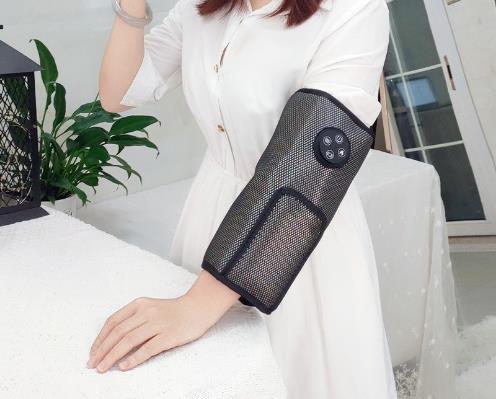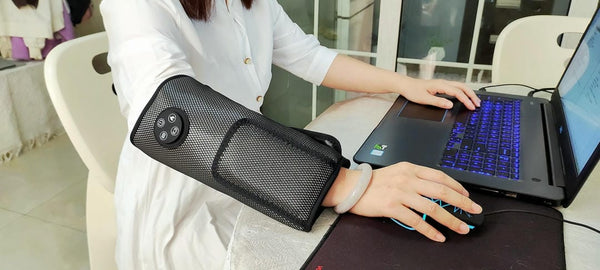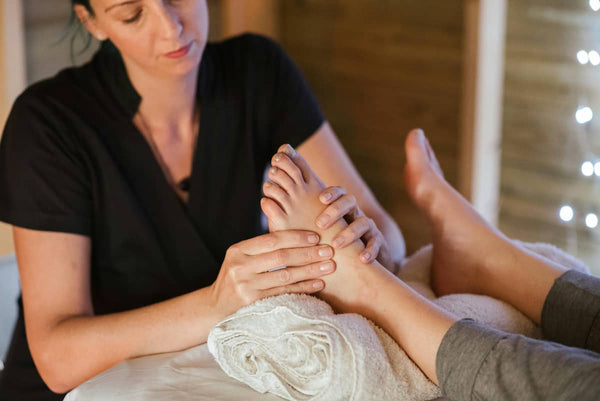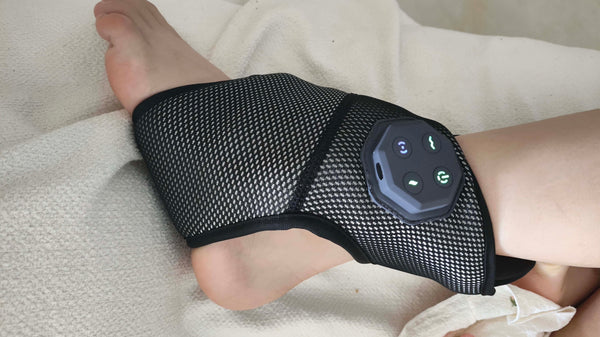 As an office worker, you're likely no stranger to the nagging discomfort of low back pain or the unwelcome heat of muscle inflammation. Hours spent hunched over a desk, often in less-than-ideal postures, can take a significant toll on your musculoskeletal system. While massage therapy is often sought for relief, it's crucial to understand its nuanced role, especially when dealing with different types of pain. This guide aims to provide practical insights into how massage can help, when it might be contraindicated, and how innovative tools like a modern massage device can fit into your wellness routine for sustained comfort. Understanding these distinctions is key to making informed choices for your back health.
As an office worker, you're likely no stranger to the nagging discomfort of low back pain or the unwelcome heat of muscle inflammation. Hours spent hunched over a desk, often in less-than-ideal postures, can take a significant toll on your musculoskeletal system. While massage therapy is often sought for relief, it's crucial to understand its nuanced role, especially when dealing with different types of pain. This guide aims to provide practical insights into how massage can help, when it might be contraindicated, and how innovative tools like a modern massage device can fit into your wellness routine for sustained comfort. Understanding these distinctions is key to making informed choices for your back health.
The allure of a good massage for alleviating pain is strong, and for good reason in many cases. However, the path to relief isn't always straightforward. We need to explore the specific nature of your discomfort – is it mechanical, stemming from tight muscles and joint stiffness, or is there an active inflammatory process at play? Answering this question is the first step towards effectively using massage and potentially incorporating a massage device to manage your symptoms. Many of the best massage devices on the market now offer features that can cater to specific needs, but knowledge is power when selecting and using them.
Understanding Low Back Pain and Muscle Inflammation in Office Workers
Low back pain in office workers often stems from a combination of factors. Prolonged sitting, particularly with poor posture, can lead to muscle imbalances, where some muscles become tight and overworked while others weaken. This mechanical strain can cause discomfort, stiffness, and restricted movement. Over time, this can manifest as chronic mechanical low back pain. From a traditional perspective, we might see this as a stagnation of Qi and Blood in the meridians of the lower back, leading to pain and dysfunction. This is the kind of pain where well-chosen massage tools can be quite beneficial.
Muscle inflammation, on the other hand, is the body's natural response to injury or irritation. Acute inflammation involves redness, heat, swelling, and pain. This can occur from a sudden strain, an overuse injury, or sometimes as part of a systemic condition. While some chronic tightness can have a low-grade inflammatory component, acute, florid inflammation requires a different approach. Applying vigorous massage directly to an acutely inflamed area can, in some cases, exacerbate the condition. It's a common misconception that all pain benefits equally from the same type of intervention, and understanding this difference is, really, really important before seeking treatment or using a massage device.
Common contributors to these issues for office workers include:
- Poor ergonomics and workstation setup.
- Sustained static postures for long durations.
- Repetitive motions, even if minor.
- Lack of regular movement and stretching breaks.
- Underlying stress, which can increase muscle tension.
The Dual Role of Massage: Relief and Risks
Massage therapy can be a powerful ally against mechanical low back pain. Techniques that focus on releasing muscle tension, improving circulation, and increasing flexibility can provide significant relief. This is where massage helps to restore the proper flow of Qi and Blood, alleviating the stagnation that contributes to pain. For instance, gentle effleurage, petrissage, and targeted trigger point therapy can address the tight bands and knots commonly found in the lower back and gluteal muscles of office workers. However, it's crucial to distinguish this from situations involving acute inflammation.
When muscle inflammation is acute – characterized by sharp pain, swelling, redness, and heat – direct, intensive massage may not be advisable as a first step. Perspective 1 rightly suggests that massage might aggravate acute inflammation. The increased blood flow and mechanical manipulation can sometimes intensify the inflammatory response. This is why Perspective 2 becomes highly relevant: anti-inflammatory techniques, such as cold compress therapy (cryotherapy), should often be performed before considering massage for an acutely inflamed area. Applying cold can help to constrict blood vessels, reduce swelling, and numb the pain, creating a more suitable environment for gentle manual therapies later on, if appropriate. Some advanced massage device models are even exploring Peltier cooling elements for this very reason, though simple ice packs are a readily available starting point.
Key considerations include:
- Mechanical Pain: Massage can help by releasing muscle knots, improving circulation, and increasing flexibility. Various massage tools can aid in this.
- Acute Inflammation: Direct massage may worsen symptoms. Prioritize rest, ice, and consult a professional.
- Chronic Inflammation/Tightness: Massage might be beneficial, but the approach should be tailored. A gentle massage device could be helpful for home management.
Navigating Massage: Approaches for Different Pain Types
 Understanding your specific type of back pain is paramount to choosing the right approach. As an office worker, you might experience a spectrum of issues, from dull, achy mechanical pain to sharper, more inflammatory sensations. My experience suggests that a tailored strategy, sometimes involving a combination of professional care and self-management with a quality massage device, yields the best long-term results.
Understanding your specific type of back pain is paramount to choosing the right approach. As an office worker, you might experience a spectrum of issues, from dull, achy mechanical pain to sharper, more inflammatory sensations. My experience suggests that a tailored strategy, sometimes involving a combination of professional care and self-management with a quality massage device, yields the best long-term results.
Addressing Mechanical Low Back Pain with Massage
For the common mechanical low back pain resulting from hours at a desk, massage can be highly effective. The focus is on alleviating muscle hypertonicity, improving local circulation, and restoring movement. Techniques like Swedish massage, deep tissue massage (applied judiciously), and myofascial release can target the specific muscle groups that become shortened and tight – such as the quadratus lumborum, erector spinae, and gluteal muscles. The use of certain massage tools, like foam rollers or massage balls, can also empower you to perform self-myofascial release at home, complementing professional treatments.
Tips/Considerations: Always communicate with your therapist about your comfort levels. It’s important to find a practitioner experienced with office-related musculoskeletal issues. If you are looking for local help, searching for "massage supplies near me" can sometimes lead you to qualified therapists or stores selling helpful massage tools. Consistency is often more beneficial than infrequent, overly intense sessions.
Managing Muscle Inflammation: When Massage Might Not Be First-Line
If your back pain is accompanied by signs of acute inflammation – such as recent onset of sharp pain, noticeable swelling, redness, or warmth to the touch – caution is advised with direct massage. As highlighted, vigorously massaging an acutely inflamed area can potentially worsen the condition by increasing irritation and fluid build-up. In these scenarios, the RICE protocol (Rest, Ice, Compression, Elevation) is typically the initial recommendation. Cold compress therapy, as mentioned in Perspective 2, can be very effective in reducing the inflammatory response. Once the acute phase subsides, gentle massage techniques might be introduced, but this should be guided by a healthcare professional.
Tips/Considerations: Pay close attention to your body's signals. If pain increases significantly during or after a massage, it may not be the right approach for your current condition. It's always better to err on the side of caution and consult with a physiotherapist or doctor if you suspect acute inflammation. They can help determine the underlying cause and the most appropriate treatment plan, which might eventually include specific types of massage or the use of a specialized massage device designed for sensitive areas.
Leveraging Massage Devices for Sustained Comfort and Prevention
Perspective 3 points to the valuable role of a massage device in reducing tightness and soreness, and this is particularly relevant for office workers seeking ongoing relief and prevention. Modern massage devices, such as percussive massagers (like some Klcosy or AUX models are known for, illustratively speaking of their type), shiatsu massagers, or those incorporating heat therapy, can be excellent for managing the chronic muscle tension that builds up from daily desk work. These devices can help improve blood flow, release trigger points, and provide a sense of relaxation and well-being. For many, finding the best massage devices involves looking for features that mimic traditional techniques, perhaps even incorporating principles like acupressure point stimulation or warming functions akin to moxibustion, which can be deeply soothing for stiff, cold-type pain patterns.
Tips/Considerations: When selecting a massage device, consider its intensity levels, attachment heads (for percussive types), and any additional features like heat. Start with lower intensity settings and gradually increase as tolerated. Use these devices to target common problem areas for office workers, like the lower back, shoulders, and neck. Consistent, short sessions can be more beneficial than infrequent long ones. Remember, a massage device is a tool; understanding how to give a good massage to yourself with it, or understanding its limits, is important. While specific data on durability varies by brand and model, looking at user reviews and manufacturer warranties can offer some insight into a device's longevity.
Tips for Incorporating Massage Safely and Effectively
To get the most out of massage therapy, whether from a professional or using a massage device at home, certain practices can enhance safety and effectiveness. Communication is key when working with a therapist; always inform them about your pain levels, areas of concern, and any changes in your condition. If you are learning how to give a good massage to a partner or using self-massage tools, start gently and listen to the body's feedback. It's not about inflicting pain, but about encouraging relaxation and release.
Hydration is also important. Drinking water before and after a massage can help flush out metabolic byproducts that may be released from the muscle tissues. Avoid overdoing it, especially when first starting with massage or using a new massage device. Muscles need time to adapt. It’s also wise to be aware of what general massage supplies are typically used by professionals, such as quality lotions or oils, to understand the process, even if you are primarily using an electronic massage device which may not require them. General observations suggest that regular, moderate massage is more beneficial than occasional, overly aggressive sessions.
Key tips for office workers include:
- Schedule regular short breaks throughout your workday to stand, stretch, and move. This can prevent excessive muscle tightness.
- Integrate gentle stretches for your back, neck, and shoulders into your daily routine.
- Consider ergonomic adjustments to your workstation to support better posture.
- If using a massage device, follow the manufacturer's instructions carefully and avoid using it on bony prominences or areas of acute injury without professional advice.
- Listen to your body: pain is a signal. If something doesn't feel right, stop and consult a professional. Many are seeking the best massage devices, but even the best tool needs to be used correctly.
When to Seek Professional Medical Advice
While massage and massage devices can be very helpful for common musculoskeletal pain, it's crucial to recognize situations where self-treatment is not appropriate and professional medical advice is necessary. Certain "red flag" symptoms associated with back pain warrant immediate consultation with a doctor or physiotherapist to rule out more serious underlying conditions. Ignoring these can lead to delayed diagnosis and treatment, potentially worsening the outcome.
Seek professional medical help if your low back pain is accompanied by any of the following:
- Sudden, severe pain, especially after an injury.
- Pain that radiates down one or both legs, particularly if associated with numbness, tingling, or weakness.
- Loss of bladder or bowel control.
- Unexplained weight loss.
- Fever or night sweats.
- Pain that is constant and progressive, or doesn't improve with rest.
- A history of cancer or recent infection.
In these instances, massage is likely not the primary solution, and a thorough medical evaluation is needed to determine the cause and appropriate management. While many find relief from a good massage device or manual therapy for everyday aches, these tools are not substitutes for medical diagnosis when serious symptoms arise. Remember, your health is paramount, and understanding when to escalate care is a key part of self-management.
Conclusion: An Informed Approach to Back Health
For office workers grappling with low back pain and muscle soreness, massage can indeed offer significant relief, particularly for mechanical issues arising from prolonged sitting and postural strain. However, a discerning approach is vital. Understanding the difference between mechanical pain and acute inflammation will guide you in choosing whether to seek massage immediately, perhaps opt for preliminary anti-inflammatory measures, or explore the benefits of a modern massage device. Incorporating insights from traditional healing philosophies with the capabilities of today's technology can lead to a more holistic and effective strategy for managing your back health.
Ultimately, the goal is to empower you with knowledge to make informed decisions. Whether it's seeking a qualified therapist, learning basic self-care techniques, or investing in one of the best massage devices suited to your needs, a proactive and educated stance can make a world of difference in your daily comfort and long-term well-being. Consider high-quality massage tools and devices as valuable components of your personal wellness toolkit, helping you to address muscle tightness and soreness effectively at home or on the go. Remember to listen to your body, and when in doubt, always consult with a healthcare professional. A good quality massage device can be a fantastic aid, but it's part of a broader approach to health.
References
Information presented in this article is based on generally accepted physiotherapy principles and traditional medicine concepts. Specific statistical data or direct research citations for all claims are not provided here but can be found in relevant academic journals and physiotherapy literature. For example, research on the efficacy of massage for non-specific low back pain is widely available on platforms like PubMed Central (PMC) or through physiotherapy association websites.




0 comments